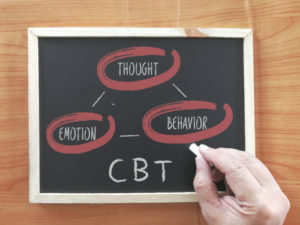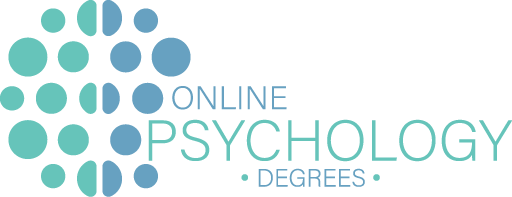
Posted October 2019 by Clifton Stamp, B.S. Psychology; M.A. Rehabilitation Counseling, M.A. English; 10 updates since. Reading time: 5 min. Reading level: Grade 10+. Questions on cognitive behavioral therapy? Email Toni at: editor@online-psychology-degrees.org.
Cognitive Behavioral Therapy (CBT), is a psychotherapeutic approach and set of techniques formed from the development of behavioral therapy (behaviorism) and Aaron Beck’s cognitive therapy. Classical CBT as practiced from the 1960s through the 2000s is still a major school of therapy. Since the onset of the new millennium, new developments within the umbrella of cognitive behavioral therapy have arisen and continued to develop, creating new ways of thinking about cognitive behavioral therapy, along with new practices. It’s worthwhile to note that all forms of CBT operate on a simple principle: internal processes affect external situations, which, once changed or affected, sometimes result in changes in one’s internal state. How we think and feel about what happens to us impacts us as much or even more than those external events themselves.
First Wave Cognitive Behavioral Therapy
First wave CBT differs radically from psychoanalysis, the years-long and empirically weak method of addressing neuroses pioneered by Sigmund Freud. First wave CBT uses the principles of operant learning and classical conditioning. First wave CBT went no further than basic learning and conditioning paradigms. Based on empirical, research-based science, first wave CBT was used in the 1940s as a short term treatment for cases of depression and severe anxiety which were endemic in veterans returning from World War II. At the time, several decades worth of useful research had accumulated that gave psychologists a ready roadmap for short treatments that delivered significant relief for veterans.
Second Wave Cognitive Behavioral Therapy
Second wave cognitive behavioral therapy came from Aaron Beck’s cognitive therapy. Based on the cognitive model, it states that people are more negatively affected by their automatic thoughts and patterns of thought about negative events than the events themselves. As well, situations can create automatic physiological reactions, like an increase in heart rate, perspiration or blood pressure, that can be interpreted cognitively as an awareness of perceived danger when there is in reality no threat at all. Simply put, our assumptions and presumptions control us and our reactions far more than events themselves. Everything we experience gets interpreted through cognitive filters. Cognitive filters are a kind of metaphorical mental shorthand that we develop over years of experiences. Unfortunately, cognitive filters tend to create cognitive distortions, that require therapy to correct.
Second wave cognitive behavioral therapy helps people to identify their automatic thoughts, reflexive thinking that occurs without reflection or even input. People can learn to identify and evaluate their cognitive distortions and automatic thinking. Cognitive behavioral therapy (CBT) itself is a kind of psychotherapy, sometimes called “talking therapy.” It explores how your cognitions (thoughts, values, attitudes and beliefs) affect your emotions and behavior. CBT emphasizes the ways that internal states, like persistent and consistent patterns of thought and beliefs affect external states, like behaviors. However, CBT honors the principle that how we behave can be powerful tools for changing maladaptive thoughts and feelings. Essentially, there are real and measurable relationships between internal states (thoughts, beliefs, patterns of established thought) and behaviors.
People who seek help in psychotherapy achieve resolution through learning how internal states like thoughts and beliefs affect their behaviors. They also learn to make changes in how they think to cope better with their lives and the challenges.
Third Wave Cognitive Behavioral Therapies: 1990 to the Present
Third wave cognitive behavioral therapies differ from second wave CBT therapies in several ways. Second wave Beckian CBT seeks to reduce and eliminate the symptoms of problems by changing behaviors, whereas third wave therapies look at more comprehensive life goals. Third wave therapies still value behavior; after all, it’s our visible behaviors that affect our entire social, psychological and professional contexts. Our lives and everything in them are guided by our behaviors, therapists are swift to reiterate. Third wave therapists are interested in doing more than simply changing what we think; third wave therapists help people change how they think and how they respond to challenging situations. Third wave CBT emphasizes accepting our thoughts within context instead of judging our thoughts as good or bad. Rather than focusing on the content of a person’s thoughts and internal experiences, third wave behavioral therapists are instead more focused on the context, processes, and functions of how a person relates to internal experiences (i.e., thoughts, urges, sensations).
All third wave therapies value holism. Holism is the view of a human being as part of a complete and unique context, comprised of intimately interconnected physical, psychological, spiritual facets that are together greater than the mere sum of their parts. Third wave CBT sees the role of the therapist as that of a facilitator for good mental health, as opposed to a technician who only helps treat “illness” or maladaptiveness. The elimination of psychological issues is thus a highly desirable side-effect of striving for the most satisfying and mentally healthy life possible.
Third Wave CBT Therapies Concepts and Therapies
Traditional cognitive behavioral therapies have been augmented by concepts such as mindfulness, acceptance and metacognition. Mindfulness is a large part of these therapies but is not a new concept. It has its roots in Eastern philosophies going back for millennia. Professor John Kabat-Zinn started a program in Mindfulness-Based Stress Reduction in 1979, but mindfulness didn’t become a driving force in mainstream third wave CBT until the 1990s. In general, there are no specific inclusion or exclusion criteria for what is or is not part of the third wave. However, some of the major therapies of the third wave include:
- Mindfulness Based Cognitive Therapy (MBCT)
- Mindfulness Based Stress Reduction (MBSR)
- Acceptance and Commitment Therapy (ACT)
- Cognitive Behavioral Analysis System of Psychotherapy (CBASP)
- Compassion Focused Therapy (CFT)
- Dialectical Behavior Therapy (DBT)
- Functional Analytic Psychotherapy (FAP)
- Behavioral Activation (BA)
All of these therapies view people as capable of growth and change. Preliminary research has shown these treatments to be effective, however much more research will have to be done to make comprehensive and conclusive statements. What isn’t in doubt is that the different waves of CBT have allowed more effective treatments to be developed and deployed to the services of millions of people, with better mental health and greater life satisfaction being the result.
More Articles of Interest:
- What is Cognitive Behavioral Psychology?
- What is Counseling Psychology?
- What is Behavioral Psychology?
- What is Neuropsychology?
- What is Color Psychology?
- What is Abnormal Psychology?
